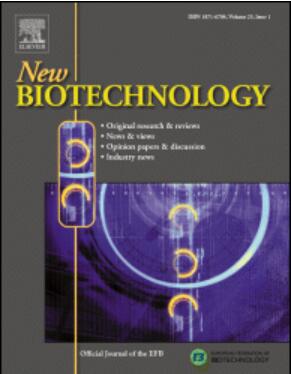酚类化合物指纹在木质素技术转化过程中显示出不同的木质素分解细菌行为
IF 4.9
2区 生物学
Q1 BIOCHEMICAL RESEARCH METHODS
引用次数: 0
摘要
木质素是植物细胞壁的主要成分之一,也是某些工业(造纸和木材工业等)的副产品,是芳香分子的可再生来源。它们可以通过已知的尊重环境的微生物和酶的过程降解和转化。由于生物催化剂不够有效和高效,木质素的生物增值仍然具有挑战性。此外,木质素的化学复杂性和异质性是其使用的障碍。通过指纹识别木质素的有效转化来了解微生物对木质素的行为,可能会导致开发有效的生物途径来提高这些芳香族聚合物的价值。木质素分解细菌在产生木质素分解酶、通过各种细胞内途径利用芳香族化合物以及从芳香族分子中产生感兴趣的分子方面呈现出一些有趣的特征。本文采用多种方法(生长研究、木质素降解活性产生、木质素修饰和酚类化合物指纹图谱)来了解两种木质素降解细菌Pandoraea norimbergensis和Comamonas composti在不同结构和来源的木质素存在下的行为。结果表明,根据细菌和使用的木质素不同,生长曲线、木质素修饰、酚类单体和低聚物的消耗和生产也不同。为了实现木质素的高效转化,需要适当的生物催化剂和木质素的组合,并且必须根据其代谢能力和木质素的结构和组成来选择使用的微生物。本文章由计算机程序翻译,如有差异,请以英文原文为准。
Phenolic compounds fingerprints show distinct ligninolytic bacteria behaviours during technical lignins conversion
Lignins, one of the main components of plant cell wall, and by-products of certain industries (paper and wood industries,…) are a renewable source of aromatic molecules. They can be degraded and transformed by microbial and enzymatic processes known to be respectful of the environment. Biological valorization of lignins remains challenging as biocatalysts are not sufficiently effective and efficient. Moreover, the chemical complexity and heterogeneity of lignins are a barrier to their use. Understanding the microbial behaviour on lignins by fingerprinting their efficient transformation could lead to the development of effective biological routes to valorise these aromatic polymers. Ligninolytic bacteria present some interesting features in term of ligninolytic enzymes productions, utilization of aromatic compounds via various intracellular pathways and the productions of molecules of interest from aromatic molecules. In this work, multiple approaches (growth studies, ligninolytic activities production, lignin modifications and phenolic compounds fingerprints) were used to understand the behaviour of two ligninolytic bacteria Pandoraea norimbergensis and Comamonas composti, in presence of lignins with different structures and origins. Results showed dissimilar growths profiles, lignin modifications, consumption and production of phenolic monomers and oligomers according to the bacteria and the lignin used. To achieve efficient transformation of lignins, suitable combination of biocatalysts and lignins is required and the microorganisms used must be selected on the basis of their metabolic capacity, and the structure and composition of lignin.
求助全文
通过发布文献求助,成功后即可免费获取论文全文。
去求助
来源期刊

New biotechnology
生物-生化研究方法
CiteScore
11.40
自引率
1.90%
发文量
77
审稿时长
1 months
期刊介绍:
New Biotechnology is the official journal of the European Federation of Biotechnology (EFB) and is published bimonthly. It covers both the science of biotechnology and its surrounding political, business and financial milieu. The journal publishes peer-reviewed basic research papers, authoritative reviews, feature articles and opinions in all areas of biotechnology. It reflects the full diversity of current biotechnology science, particularly those advances in research and practice that open opportunities for exploitation of knowledge, commercially or otherwise, together with news, discussion and comment on broader issues of general interest and concern. The outlook is fully international.
The scope of the journal includes the research, industrial and commercial aspects of biotechnology, in areas such as: Healthcare and Pharmaceuticals; Food and Agriculture; Biofuels; Genetic Engineering and Molecular Biology; Genomics and Synthetic Biology; Nanotechnology; Environment and Biodiversity; Biocatalysis; Bioremediation; Process engineering.
 求助内容:
求助内容: 应助结果提醒方式:
应助结果提醒方式:


